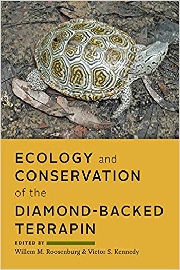Ecology and Conservation of the Diamond-Backed Terrapin

Willem M. Roosenberg and Victor S.Kennedy (Eds)
John Hopkins University Press, £59.00
The editors have compiled an authoritative volume on this important North American reptile, it harnesses the passion and sense of urgency for this threatened resident of ever-diminishing salt marshes.
Thirty-six eminent scientists have contributed to the text which is made up of two parts, one focuses on biology and ecology, the other on fisheries and conservation.
Melaclemys terrapin has seven sub-species and is the only terrapin which resides permanently in brackish waters of all the 335 extant species. The book reviews literature which is contributing to the understanding of this highly threatened species whose demise began when it was recognised as being of great economic value as a human food source in the late nineteenth century, the over-exploitation on numbers was enhanced by the slow growth, delayed maturity and low fecundity of the species.
The authors deal thoroughly with their areas of interest, which include field techniques, evolution, taxonomy, phylogeography, life history, reproductive and hatchling behaviour, osmoregulation, sex determination, habitat choice and environmental toxicology. Terrapins are now off the commercial menu but the threats continue, discussion hence revolves around habitat loss, commercial fisheries and artificial propagation, by-catch, road mortality, interactions with motorboats, habitat restoration, education and conservation.
The gaps in our knowledge of this highly endangered vertebrate who shared the planet with the dinosaurs offer great opportunities for research. The Diamond-Backed Terrapin can be found along the Gulf and Atlantic coasts of the USA and also Bermuda, the programme for its comprehensive conservation needs research, rehabilitation, education and community engagement as demonstrated by the Georgia Sea Turtle Centre, a place now on my wish list to visit.
Jean Wilson MBE C.Biol FRSB


